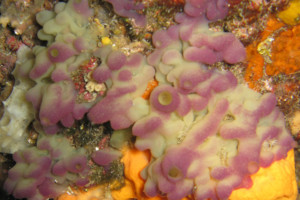Generalities
Sponges (Porifera) form a vast lineage of marine metazoans (animals) including about 10,000 species, recently subdivided into four groups: calcispongia, hexactinellida, demospongiae and homoscleromorpha (Gazave et al., 2011). Although their phylogenetic position is still debated within the scientific community, it is acknowledged that they represent one of the first lines of metazoans still present on earth to have emerged. Sponge models are still rare at the international scale and are little known from a genomic point of view. Oscarella lobularis, of the homoscleromorpha group, is currently being studied in France as an evo-devo model.
Oscarella lobularis has a well-developed basal lamina containing type IV collagen at all stages of development. This basal lamina implies that the morphogenesis processes are predominantly epithelial : it is therefore a major interest of this group of sponges in evo-devo studies. This species is very well described and widely available in the Mediterranean sea. It does not have a mineral skeleton (sponge without spicule, as in other Oscarellidae), which facilitates its study. The complete sequencing of the genome is expected in the coming years.
Other characteristics :
– Well described embryonic development, life cycle, morpho-anatomy of larval and adult stages: to note the presence of a basal membrane, and lack of archaeocytes.
– Presence of symbiotic bacteria
– Secondary metabolites synthesis
Reproduction
Well known life cycle: asexual reproduction (budding) and sexual reproduction (gonochorism) in summer.
Oscarella lobularis is a common species in the Mediterranean sea, locally abundant on the coast and easily collected by scuba diving or snorkelling. There is a risk of mixing with its sister species Oscarella tuberculata, morphologically very similar and often found in sympatry, and it requires a trained eye to distinguish them (or a morphological and histological check).
A whole individual or a fragment of an individual can be kept in an open-circuit seawater aquarium (ideally with a piece of substrate). Fragments of individuals can easily be kept for 1 to 2 weeks in a petri dish with seawater renewed regularly in a thermostatically controlled chamber.
Tools
- EST library - clones (about 2.000 sequences)
- Annotated EST library (about 70.000 sequences)
- In situ Hybridation
- Immunohistochemistry
- Dissociation and reaggregation of cells
- Functional studies via chemical treatments (pharmacological approaches)
Databases
World Porifera Database :
Infrastructures
- Institut Méditerranéen de Biodiversité et d’Ecologie marine et continentale (IMBE), équipe IDEA - UMR CNRS7263 IRD237 AMU UAPV
- www.imbe.fr
- Marseille
Experts
- Alexander ERESKOVSKY
- alexander.ereskovsky@imbe.fr
- Institut Méditerranéen de Biodiversité et d’Ecologie marine et continentale - UMR CNRS7263 IRD237 AMU UAPV, Marseille
Bibliography
- Articles
″Pluri-annual study of the reproduction of two Mediterranean Oscarella species (Porifera, Homoscleromorpha): cycle, sex-ratio, reproductive effort and phenology.″ Ereskovsky, A.V., Dubios, M., Ivanisevic, J., Gazave, E., Lapebie, P., Tokina, D., Pérez, T. Mar. Biol. 160: 423-438, 2013
″The comparative embryology of sponges″, Ereskovsky, A. V. (2010), Springer Verlag, Dordrecht, Heidelberg, London, New York.
″Systematics and molecular phylogeny of the Oscarellidae family (Homoscleromorpha) with description of two new Oscarella species.″ Gazave, E., Lavrov, D., Cabrol, J., Renard, E., Rocher, C., Vacelet, J., Adamska, M., Borchiellini, C., Ereskovsky, AV. PLos One, 2013
″The homoscleromorph sponge Oscarella lobularis as model in evolutionary and developmental biology.″ Ereskovsky, A.V., Borchiellini, C., Gazave, E. Ivanisevic, J., Lapébie, P., Perez, T., Renard-Deniel, E., Vacelet, J., BioEssays. 31(1), 89-97, 2009
″Isolation of five new 5-hydroxy-6-keto-7 sterols from the marine sponge Oscarella lobularis.″ Aiello, A., Fattorusso, E.,Magno, S. and Menna,M., Steroids. 56: 337–340, 1991
″Type IV collagen in sponges, the missing link in basement membrane ubiquity.″ Boute N, Exposito J-Y, Boury-Esnault N, Vacelet J, Noro N. et al, Biol Cell 88: 37-44, 1996
